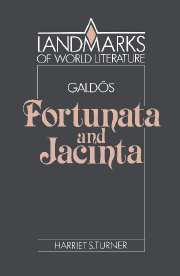Book contents
2 - Characters and configurations
Published online by Cambridge University Press: 18 December 2009
Summary
Two-by-fours
The entrepreneurial energies of the age appear to build character as Galdós assembles the novel in four parts and juxtaposes titles and subtitles to reflect a dialectic within the patriarchal consciousness that dominates the times. The names of the two protagonists, unattached to married surnames, show how Fortunata and Jacinta preside over the novel, whereas the four parts correspond to the introduction of four male characters, whose presence initially places the two women in the background. Once the story starts, however, imagistic progressions create a female mode as the bird-egg motif mounts up, culminating in the birth of the child. The two main organizing principles – four (male) divisions and the bird-egg motif (female) – which build the unity of the four parts, converge in the child who resolves the dialectic by reconciling the two women.
As the two stories develop within four parts, building with two-by-fours becomes a unifying motif, since the characters as well as the author act as builders. In the role of social historian, the narrator builds his account of the Santa Cruzes with the wood and running vines of the family tree. Guillermina founds her orphanage, petitioning stone, bricks, beams. Barbarita stockpiles provisions as barricades go up in the streets, and holds forth on architecture in her drawing room. In the Rubín household, doña Lupe builds up capital while Nicolás builds his ecclesiastical career on the edification of Fortunata, “digging a foundation” upon which Feijoo will reconstruct and restore the broken Rubín marriage.
- Type
- Chapter
- Information
- Galdós: Fortunata and Jacinta , pp. 50 - 91Publisher: Cambridge University PressPrint publication year: 1992



